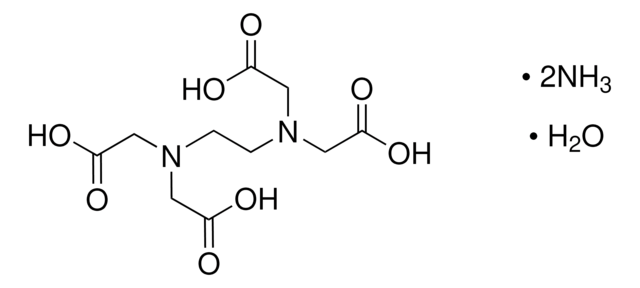03685
Acide éthylènediaminetétraacétique disodium salt dihydrate
≥97.0% (KT)
Synonyme(s) :
EDTA disodium salt, EDTA-Na2, Edétate disodium salt dihydrate, Sequestrene Na2, Édathamil, Éthylènediaminetétraacétate disodique dihydrate
About This Item
Produits recommandés
Niveau de qualité
Pureté
≥97.0% (KT)
Pf
248 °C (dec.) (lit.)
Solubilité
H2O: 100 g/L at 20 °C
Chaîne SMILES
O.O.O.O.[Na+].[Na+].[Na+].[Na+].OC(=O)CN(CCN(CC([O-])=O)CC([O-])=O)CC(O)=O.OC(=O)CN(CCN(CC(O)=O)CC([O-])=O)CC([O-])=O
InChI
1S/C10H16N2O8.2Na.2H2O/c13-7(14)3-11(4-8(15)16)1-2-12(5-9(17)18)6-10(19)20;;;;/h1-6H2,(H,13,14)(H,15,16)(H,17,18)(H,19,20);;;2*1H2/q;2*+1;;/p-2
Clé InChI
OVBJJZOQPCKUOR-UHFFFAOYSA-L
Vous recherchez des produits similaires ? Visite Guide de comparaison des produits
Catégories apparentées
Description générale
Application
Mention d'avertissement
Warning
Mentions de danger
Conseils de prudence
Classification des risques
Acute Tox. 4 Inhalation - STOT RE 2 Inhalation
Organes cibles
Respiratory Tract
Code de la classe de stockage
11 - Combustible Solids
Classe de danger pour l'eau (WGK)
WGK 2
Point d'éclair (°F)
Not applicable
Point d'éclair (°C)
Not applicable
Équipement de protection individuelle
Eyeshields, Gloves, type N95 (US)
Choose from one of the most recent versions:
Déjà en possession de ce produit ?
Retrouvez la documentation relative aux produits que vous avez récemment achetés dans la Bibliothèque de documents.
Les clients ont également consulté
Notre équipe de scientifiques dispose d'une expérience dans tous les secteurs de la recherche, notamment en sciences de la vie, science des matériaux, synthèse chimique, chromatographie, analyse et dans de nombreux autres domaines..
Contacter notre Service technique








